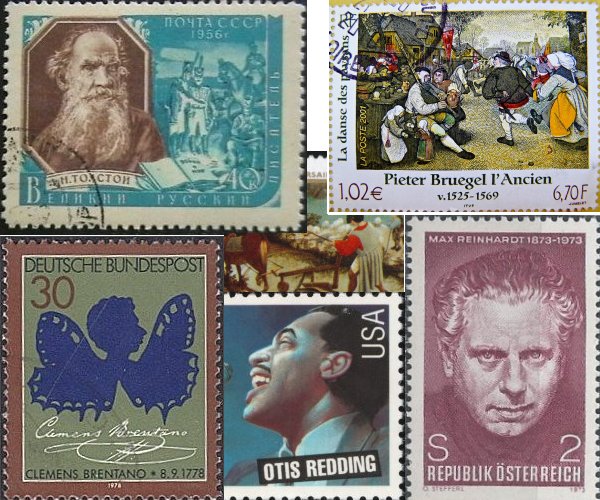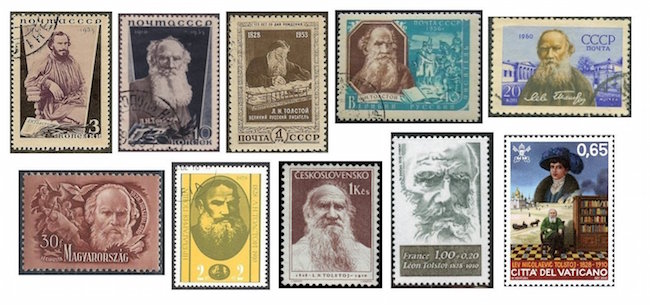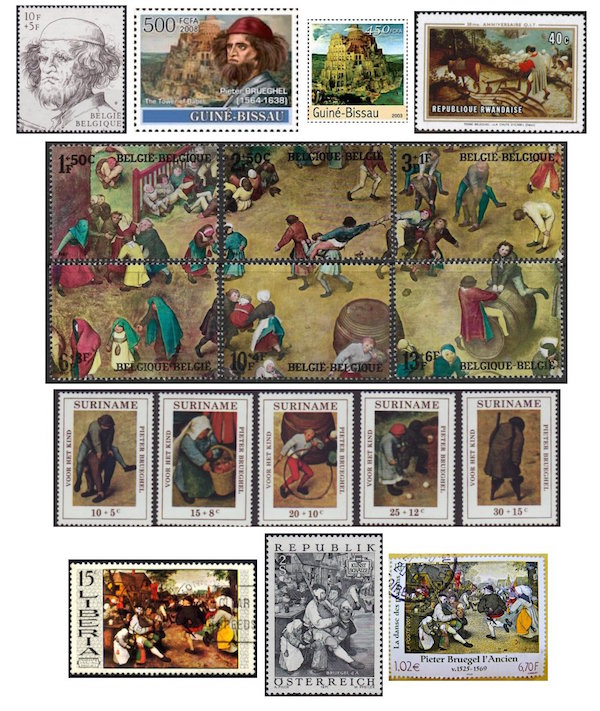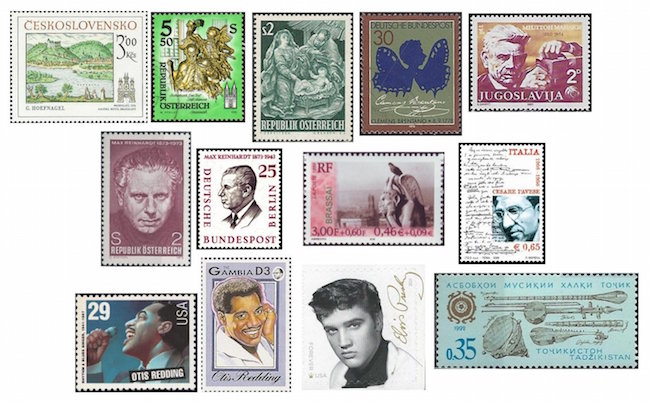The Arts on Stamps of the World — September 9
An Arts Fuse regular feature: the arts on stamps of the world.

By Doug Briscoe
The Big-Leaguers for September 9 are Leo Tolstoy and Pieter Brueghel the Elder, with Clemens Brentano, Max Reinhardt, Cesare Pavese, and Otis Redding on deck, and a number of promising players coming up from the Minors.
What I often do here with the titans of literature, given that you already know all about them anyway, is to concentrate on the musical works their literary efforts have inspired. The best known opera after Leo Tolstoy (9 September [O.S. 28 August] 1828 – 20 November [O.S. 7 November] 1910) is Prokofiev’s War and Peace (first completed 1943; final revision 1952), but many years earlier the Italian composer Franco Alfano had written Risurrezione (1904) after Tolstoy’s novel Resurrection, which also provided a scenario for an even earlier symphonic poem by Albert Roussel (his Op. 4 of 1903), as well as for a 1960 opera by the Slovak composer Ján Cikker. Anna Karenina was made into operas by Hubay (1915), Robbiani (1924), and Goldbach (1930) and much more recently by Scottish composer Iain Hamilton (1981) and the American David Carlson (2007). Janáček had started work on one in 1907 but left it unfinished; he also abandoned an opera (1916) on the Tolstoy play The Living Corpse. Later, Janáček did complete a string quartet (1923), one of his finest works, inspired by Tolstoy’s story “The Kreutzer Sonata”. A cantata on War and Peace by Louis Durey (1949), Bohuslav Martinů’s opera for television What Men Live By (1952), Shchedrin’s ballet Anna Karenina (1972), and film music by Constant Lambert (for the Vivien Leigh version of Anna Karenina in 1948), Nino Rota (for King Vidor’s 1956 War and Peace), and Vyacheslav Ovchinnikov (for the Bondarchuk version of 1967) are more examples of music after Tolstoy.

Wikipedia unhesitatingly calls Pieter Brueghel the Elder “the most significant artist of Dutch and Flemish Renaissance painting.” Brueghel was not born on the 9th, his exact birth date remaining unknown to us, but he expired on this date in 1569. Born sometime around 1525-30, he was a member of the Antwerp artists’ guild by 1551. Shortly thereafter he undertook a journey to Italy. On his return in 1554/55, he married and got to work producing his finest pieces. After 1559 he no longer used the ‘h’ and signed himself as “Bruegel”. He was somewhat unusual in that he painted no portraits, unless The Painter and The Connoisseur (c1565) is a self-portrait with an unidentified aesthete. Our first stamp, one of several Belgian designs we have before us, shows a detail of that drawing, and the stamp next to it, from Guinea-Bissau, combines a colorized realization of the Brueghelian head with a partial view of the famous Tower of Babel (large version, 1563), seen again all by itself on another stamp from the same country. At the far right of the first row is a Rwandan stamp showing a detail from Landscape with the Fall of Icarus. In this design Icarus is excluded altogether, although even in the original one has a hard time picking him out. In the full version (follow the link) the unfortunate youth can be seen to have fallen, melted wings and all, into the sea, where his legs are thrashing just below the ship at right. This painting is now believed to be an early copy by an unknown hand of Bruegel’s lost original, thought to date from about 1558. At the center of our display is a set of six Belgian stamps showing a substantial detail from Children’s Games (1560), and beneath that another set of stamps from Suriname showing a few of the individual games. More fun is being had by all in The Peasant Dance (1568), seen on stamps of Liberia, Austria, and France.

Another Flemish painter and printmaker who died on this date (in 1600) was Joris (or Georg) Hoefnagel. Born in Antwerp in 1542, he received a comprehensive education, learning several languages and learning to play a number of musical instruments. He also wrote poetry. He lived in France and Spain and, for a few months, London, later traveling to Germany and Italy. He was taken on by Albert V, Duke of Bavaria, as court painter at Munich. His devotion to Calvinism got him expelled from Munich in 1591 and from Frankfurt, where he was employed by Holy Roman Emperor Rudolf II, in 1594. The Czech stamp offers Hoefnagel’s view of Bratislava. By the way, you may recall that recently we saluted the painter Lavinia Fontana, who left us a portrait of Antonietta González, the daughter of the first man in history known to have been afflicted with hypertrichosis. That man, Pedro González or Petrus Gonsalvus, was painted by Hoefnagel for an illustrated natural history called The Four Elements (1575-82).
Two pieces by the Austrian sculptor Josef Anton Stammel (baptized 9 September 1695; died 21 December 1765) of Graz have appeared on stamps from his country. One shows a piece from Admont Abbey in Styria, a monastery with which he was associated almost exclusively from the time of his return from a study tour in Italy in 1726. The other one is labeled merely as “Baroque creche”, and I’m not able to determine its location. Incidentally, this is another stamp engraved by Wednesday’s Hans Ranzoni.
The work of Clemens Brentano (9 September 1778 – 28 July 1842) was set by many different composers. His sister Bettina was a correspondent of Goethe and married the poet Achim von Arnim, with whom Brentano worked on his most celebrated project, Des Knaben Wunderhorn (The Youth’s Magic Horn), a collection of German folk poems and songs known to music lovers through Mahler’s big orchestral cycle of the same name and through settings by Weber, Mendelssohn, Schumann, Brahms, Loewe, Zemlinsky, Schoenberg, Webern and many others (not to mention Adrian Leverkühn). Mahler was fascinated with Des Knaben Wunderhorn and, besides the eponymous cycle, wrote other settings and used the texts in his Second, Third, and Fourth Symphonies. The stamp came out in 1978 for Brentano’s bicentennial.
Milton Manaki (9 September 1882 – 5 March 1964) was the younger of two brothers who worked as pioneers in photography and motion pictures in the Balkans. It seems Yanaki and Milton Manaki were the first to create cinema not only on the peninsula but anywhere in the Ottoman Empire. Born in a village in northern Greece to a wealthy landowning family, the brothers came to identify with Romanian—properly Aromanian—culture. It was Yanaki who showed a greater interest in painting and photography in his school years, and he who taught art and opened a photographic studio in 1898. Milton came on board at his brother’s request. Both fond of travel, the brothers purchased a motion picture camera in England and made their first short film in 1908/09. By this time they had been named official photographers to the King of Romania. They documented the events of their time such as the First Balkan War and World War I, in which their studio was bombed. Later, after Yanaki gave up photography in 1935, Milton went on to record thousands of moments during the Second World War. Most of the brothers’ films, the majority lasting at or under two minutes and none longer than 16 minutes, were made between 1905 and 1912. I don’t know why Milton alone was honored on this Yugoslav stamp of 1980, but I suppose it was because of the solo work he did without Yanaki in the 1940s.
One of the pre-eminent theater directors and producers of his day was Max Reinhardt (September 9, 1873 – October 30, 1943), born Maximilian Goldmann near Vienna. He started as an actor and co-founded a cabaret stage in Berlin in 1901. Much of Reinhardt’s greatness lay in the innovations he introduced to theatrical productions. These ideas formed the basis of the curriculum for the Max Reinhardt Seminar, which has seen many eminent actors and directors among its students: F.W. Murnau, Max Schreck, Conrad Veidt, Marlene Dietrich, Paul Henreid, Senta Berger, Hedy Lamarr, and Christoph Waltz are some names you may know. In 1920 Reinhardt founded the the Salzburg Festival. By 1930 he was in charge of eleven stages in Berlin and one in Vienna. After some stage work in America, he directed James Cagney, Mickey Rooney, and Olivia de Havilland in a celebrated film of A Midsummer Night’s Dream (1935). With the annexation of Austria by Germany, Reinhardt emigrated to to the UK, then to the US, where he lived the rest of his life.
Also a filmmaker, though better known as a photographer, was the artist known as Brassaï (9 September 1899 – 8 July 1984). He was born Gyula Halász in what today is Romania to an Hungarian father and an Armenian mother. His father taught French lit at the Sorbonne. Young Gyula was drawn to painting and sculpture and studied those disciplines in Budapest before serving in the cavalry in World War I. From 1920 he was working as a journalist in Berlin, then relocated to his permanent home of Paris in 1924. One of his mentors in photography was fellow Hungarian André Kertész. Brassaï at this time adopted his pseudonym from the town of Brassó where he was born.

Italian writer and critic Cesare Pavese (9 September 1908 – 27 August 1950) is our next subject. His birthplace was a little town between Genoa and Turin, where he mostly went to school. His thesis at the university there was on Whitman. He was arrested by the fascists in 1935 and incarcerated for more than a year; during the war he joined the partisans but was unable to fight on account of his asthma. Later, depression, a failed love affair, and political events led him to commit suicide with barbiturates. Pavese also wrote poetry and made many translations from English: Moll Flanders, David Copperfield, Moby Dick, Sherwood Anderson, Joyce, Steinbeck, John Dos Passos, and more.
Otis Redding (September 9, 1941 – December 10, 1967) gets two stamps. One of them, the American one, comes from the same extensive set as the Patsy Cline stamp we saw yesterday, a set that over several years touched on all aspects of American music. Ironically, Redding, too, was killed in a plane crash. The other stamp comes from an attractive Gambian sheet of popular American singers. (Speaking of plane crash victims, we saw the Buddy Holly stamp from this same set two days ago.) Redding was performing professionally while still in his mid-teens. His first album was released on the first day of 1964. Though he lived for only three more years he left a legacy as one of the foremost practitioners, as both singer and songwriter, of soul music and rhythm and blues.
Mea maxima culpa. I just realized that somehow, inexcusably, I missed Elvis Presley’s birthday back in January. I know this does not go far to remedy my shocking lapse, but September 9, 1956, was the date on which Elvis first appeared on the Ed Sullivan Show. So here’s the most recent Elvis stamp, just issued by the USPS two years ago.
September 9 is Tajikistan Independence Day, so I offer a lovely stamp depicting various folk instruments of the region.
I also want to acknowledge the brilliant critic and Henry James biographer Leon Edel (9 September 1907 – 5 September 1997). His five-volume work on James is one of the things that has given me the greatest reading pleasure.
A graduate of the University of Massachusetts with a B.A. in English, Doug Briscoe worked in Boston classical music radio, at WCRB, WGBH, and WBUR, for about 25 years, beginning in 1977. He has the curious distinction of having succeeded Robert J. Lurtsema twice, first as host of WGBH’s weekday morning classical music program in 1993, then as host of the weekend program when Robert J.’s health failed in 2000. Doug also wrote liner notes for several of the late Gunther Schuller’s GM Recordings releases as well as program notes for the Boston Classical Orchestra. For the past few years he’s been posting a Facebook “blog” of classical music on stamps of the world, which has now been expanded to encompass all the arts for The Arts Fuse.
